On the first weekend of a new year and a new decade, what better way to celebrate than to take a trip out of town? I did not go far—about 30 kilometers—to Gwangju, but not the big city in the southwest corner of the country. To differentiate, the people there add the name of the province and call it Gyeonggi Gwangju.
I got on the Seoul subway, took the driverless Shinbundang Line to Pangyo, transferred to the Gyeonggang Line and disembarked just before 11 a.m. I strolled over to a tourist booth just outside Gyeonggi Gwangju Station, and a nice young woman gave me a map and other brochures and even 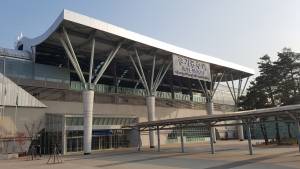 directed me to the area where most of the hotels were situated. Once there, however, I was a bit dismayed to learn that all of them charged at least 80,000 won for one night, about 40K more than I am used to paying. Perhaps the high rates can be attributed to the proximity to Seoul, but that’s just a guess. Aggravating me further was the fact that the ondol (floor heating) of my room on the third floor of the Sun Hotel worked poorly. I shivered there on Saturday night and Sunday morning.
directed me to the area where most of the hotels were situated. Once there, however, I was a bit dismayed to learn that all of them charged at least 80,000 won for one night, about 40K more than I am used to paying. Perhaps the high rates can be attributed to the proximity to Seoul, but that’s just a guess. Aggravating me further was the fact that the ondol (floor heating) of my room on the third floor of the Sun Hotel worked poorly. I shivered there on Saturday night and Sunday morning.
As usual, I began by walking around the neighborhood just to get my bearings. Further afield, I spotted a Korean War memorial. In my travels around the country over the last 12 years, I have seen perhaps 80 such sites. You might think I would have become inured to them: “Oh, another Korean War memorial.” 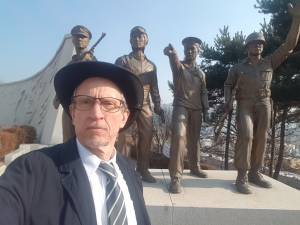 Not so. I always pause and reflect and remember the sacrifices made by people—not all of them Korean, by the way—to establish and preserve freedom.
Not so. I always pause and reflect and remember the sacrifices made by people—not all of them Korean, by the way—to establish and preserve freedom.
When I happened upon the city’s modest sports stadium, I went on in. I studied the Gyeonggi Gwangju map while watching a group of boys kick around some soccer balls. I returned to the subway and traveled a short distance to Gonjiam. I did not seek the crumbling ruins of the Gonjiam Psychiatric Hospital—ranked by CNN Travel in 2012 as “one of the 10 freakiest places in the world” and the subject of a recent horror film. Supposedly haunted by the ghosts of insane patients and doctors who conducted hideous experiments, it in fact closed 20 years ago for mundane reasons like financial mismanagement and poor sanitation. Instead, I was drawn to the Gyeonggi Ceramic Museum.
I did not know before, but I surely learned in the Gyeonggi Ceramic Museum, that for more than four centuries Gwangju was the epicenter of a series of kilns known as bunwon that produced white porcelain 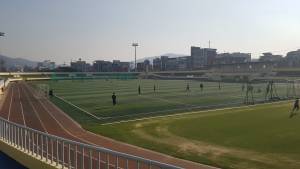 ware for the royal family and central government. It was used for everyday purposes like holding food or drink, but also for ritualistic purposes, and I will give you what I consider a rather extreme example. When the queen, a royal concubine or a princess had a baby, the placenta would be placed in a special porcelain container and buried in a certain place in a certain way at a certain time of day. I suppose this was done to ensure a virtuous life for the child when he/she grew up.
ware for the royal family and central government. It was used for everyday purposes like holding food or drink, but also for ritualistic purposes, and I will give you what I consider a rather extreme example. When the queen, a royal concubine or a princess had a baby, the placenta would be placed in a special porcelain container and buried in a certain place in a certain way at a certain time of day. I suppose this was done to ensure a virtuous life for the child when he/she grew up.
There were hundreds of bunwon kilns, mostly in and around Gwangju. This industrial-scale production of graceful pottery was interrupted only during the Hideyoshi invasions of 1592–1598. It lasted until 1884, at which time the Japanese—back again!—privatized the system and began importing their own, of distinctly lower standards.
I returned to Gyeonggi Gwangju, rambling here and there. On one hilly street, I first heard and then saw a man singing into a microphone. He was not alone, as several other people were operating a portable grill and making bungeo-ppang (literally translated as “carp bread”); batter filled with red bean paste is poured into a fish-shaped waffle iron. It is one of Korea’s most popular winter street foods, one I had sampled many times before. These friendly people offered me one, along with a cup of warm tea. I learned that the man with the mic was the senior pastor of Gwangju Yekwang Presbyterian Church, located on the second 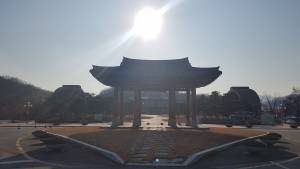 floor of the building we stood in front of. The others were church members, from pre-teen to late middle age. Soon, the junior pastor stepped forward and introduced himself as Peter. After I finished my snack, we went upstairs to look at their little church. I found it charming and promised Peter that I would return for the next day’s worship service.
floor of the building we stood in front of. The others were church members, from pre-teen to late middle age. Soon, the junior pastor stepped forward and introduced himself as Peter. After I finished my snack, we went upstairs to look at their little church. I found it charming and promised Peter that I would return for the next day’s worship service.
Dinner consisted of a bag of take-out fried chicken and a Pepsi, all consumed at the counter of a 7-11 while I read 20 pages of a biography about Jimi Hendrix and sent Kakao messages to friends.
I would be remiss if I failed to mention Raja. I saw him from a distance—a foreigner like me, although clearly not of European descent. He was passing out leaflets of some sort and doing it with the kindest smile I had ever seen. We talked amiably. Raja said he hailed from Karachi, Pakistan. Truth be told, if his literature had pertained to Mohammedanism, something about a local mosque or a restaurant serving halal food, I would not have been pleased. He would have realized it, too. I asked for one of his leaflets, 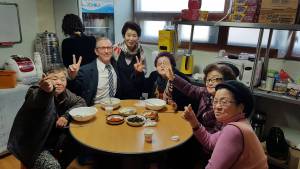 saw a drawing of the Last Supper and realized it was about the one true faith! A Pakistani Christian, now that is a rarity. I have read depressing stories about how Christians there are persecuted and killed as a matter of course. I was happier to meet Raja than he could have known.
saw a drawing of the Last Supper and realized it was about the one true faith! A Pakistani Christian, now that is a rarity. I have read depressing stories about how Christians there are persecuted and killed as a matter of course. I was happier to meet Raja than he could have known.
On Sunday morning, I just had time to down a cup of café latte and take a taxi to the church. When I walked in, Peter was surprised. He did not really think I would fulfill my promise and come back. The service lasted 90 minutes as both pastors spoke, the eight-member choir sang, an elder read from the Bible and commented, and the collection plate was passed. I was introduced and spoke briefly, apologizing for using English although a few Korean words were employed. Peter translated and mentioned my work to extricate Jikji from the French.
There was more, as I expected. We all adjourned to some rooms around the corner and had a delicious lunch. There I signed a copy of Jikji, and One NGO’s Lonely Fight to Bring It Home, gave a Jikji T-shirt to Peter’s daughter and posed for photos. Let me say, it was cold outside but warm inside—in more ways 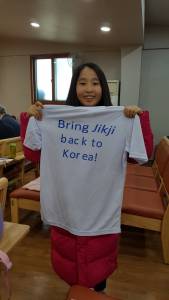 than one. Was I a rarity? Peter said that in the 17-year history of his church, just one other foreigner, a lady from Mongolia, had attended.
than one. Was I a rarity? Peter said that in the 17-year history of his church, just one other foreigner, a lady from Mongolia, had attended.
The time came for me to depart, and kind goodbyes were said. A taxi took me to Gyeonggi Gwangju Station, and I was back in Seoul by late afternoon. I quickly realized that I was missing an envelope filled with money. It had either been left at the church or in the taxi. If it was the latter, my cash was irretrievably gone. But it was the former, as Peter called me without delay. I gave him my bank account information, and he wired 212,000 won to me the next day.

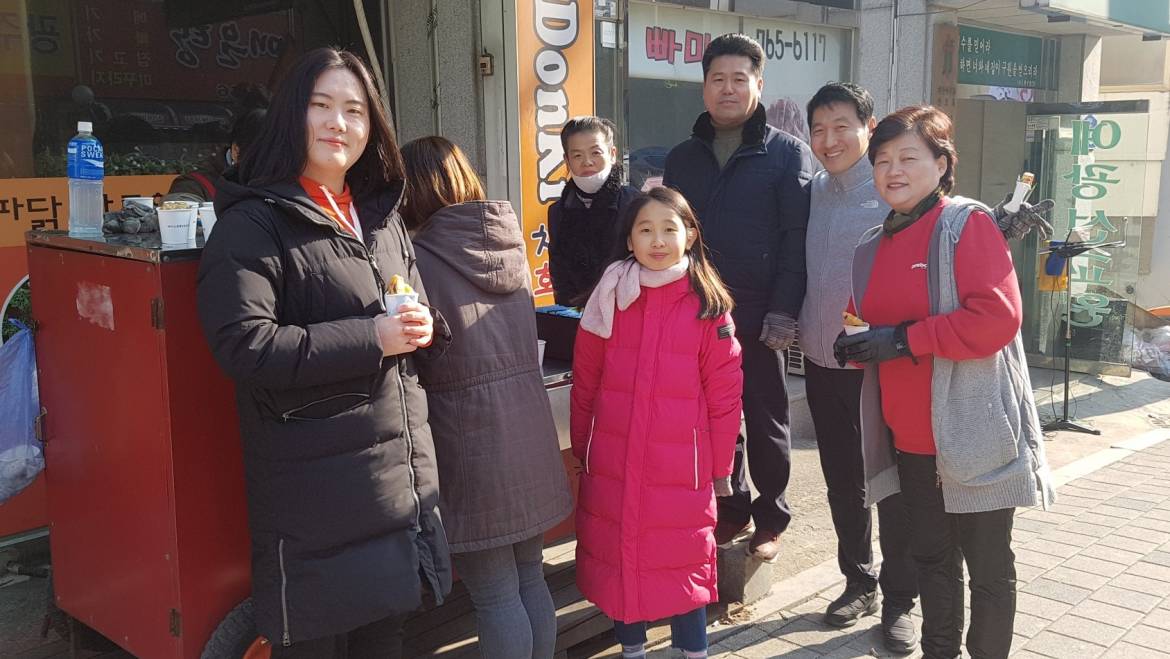
Add Comment